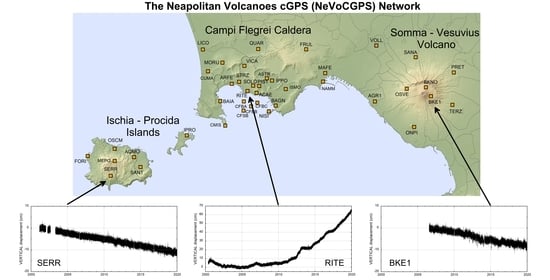The Ground Deformation History of the Neapolitan Volcanic Area (Campi Flegrei Caldera, Somma–Vesuvius Volcano, and Ischia Island) from 20 Years of Continuous GPS Observations (2000–2019)
Abstract
1. Introduction
2. The Neapolitan Volcanoes Continuous GPS Network
3. Data Processing
4. Results
4.1. Campi Flegrei Caldera
4.2. Ischia and Procida Islands
4.3. Somma–Vesuvius Volcano
5. Discussion and Conclusions
Supplementary Materials
Author Contributions
Funding
Acknowledgments
Conflicts of Interest
References
- Ricci, T.; Barberi, F.; Davis, M.S.; Isaia, R.; Nave, R. Volcanic risk perception in the Campi Flegrei area. J. Volcanol. Geotherm. Res. 2013, 254, 118–130. [Google Scholar] [CrossRef]
- Orsi, G.; de Vita, S.; Di Vito, M.A. The restless, resurgent Campi Flegrei nested caldera (Italy): Constraints on its evolution and configuration. J. Volcanol. Geotherm. Res. 1996, 74, 179–214. [Google Scholar] [CrossRef]
- Deino, A.L.; Orsi, G.; de Vita, S.; Piochi, M. The age of the Neapolitan Yellow Tuff caldera forming eruption (Campi Flegrei caldera–Italy) assessed by 40Ar/39Ar dating method. J. Volcanol. Geotherm. Res. 2004, 133, 157–170. [Google Scholar] [CrossRef]
- Vitale, S.; Isaia, R. Fractures and faults in volcanic rocks (Campi Flegrei, southern Italy): Insight into volcano-tectonic processes. Int. J. Earth Sci. 2014, 103, 801–819. [Google Scholar] [CrossRef]
- Di Vito, M.A.; Isaia, R.; Orsi, G.; Southon, J.; de Vita, S.; D’Antonio, M.; Pappalardo, L.; Piochi, M. Volcanism and deformation since 12,000 years at the Campi Flegrei caldera (Italy). J. Volcanol. Geotherm. Res. 1999, 91, 221–246. [Google Scholar] [CrossRef]
- Isaia, R.; Marianelli, P.; Sbrana, A. Caldera unrest prior to intense volcanism in Campi Flegrei (Italy) at 4.0 ka B.P.: Implications for caldera dynamics and future eruptive scenarios. Geophys. Res. Lett. 2009, 36, L21303. [Google Scholar] [CrossRef]
- Smith, V.C.; Isaia, R.; Pearce NJ, G. Tephrostratigraphy and glass compositions of post-15 kyr Campi Flegrei eruptions: Implications for eruption history and chronostratigraphic markers. Quat. Sci. Rev. 2011, 30, 3638–3660. [Google Scholar] [CrossRef]
- Di Renzo, V.; Arienzo, I.; Civetta, L.; D’Antonio, M.; Tonarini, S.; Di Vito, M.A.; Orsi, G. The magmatic feeding system of the Campi Flegrei caldera: Architecture andtemporal evolution. Chem. Geol. 2011, 281, 227–241. [Google Scholar] [CrossRef]
- Di Vito, M.; Acocella, V.; Aiello, G.; Barra, D.; Battaglia, M.; Carandente, A.; Del Gaudio, C.; de Vita, S.; Ricciardi, G.P.; Ricco, C.; et al. Magma transfer at Campi Flegrei caldera (Italy) before the 1538 AD eruption. Sci. Rep. 2016, 6, 32245. [Google Scholar] [CrossRef]
- Günther, R.T. Contribution to the Study of Earth Movements in the Bay of Naples; Parker and Son: Oxford, UK, 1903. [Google Scholar]
- Parascandola, A. I Fenomeni Bradisismici del Serapeo di Pozzuoli; Stabilimento Tipografico G. Genovese: Naples, Italy, 1947. [Google Scholar]
- Dvorak, J.J.; Mastrolorenzo, G. The mechanisms of recent vertical crustal movements in Campi Flegrei caldera, southernItaly. Geol. Soc. Am. 1991, 263, 1–47. [Google Scholar]
- Morhange, C.; Bourcier, M.; Laborel, J.; Giallanella, C.; Goiran, J.P.; Crimaco, L.; Vecchi, L. New data on historical relative sea level movements in Pozzuoli, Phlaegrean Fields, Southern Italy. Phys. Chem. Earth (Part A) 1999, 24, 349–354. [Google Scholar] [CrossRef]
- Morhange, C.; Marriner, N.; Laborel, J.; Todesco, M.; Oberlin, C. Rapid sea-level movements and non eruptive crustal deformations in the Phlegrean Fields caldera, Italy. Geology 2006, 34, 93–96. [Google Scholar] [CrossRef]
- Del Gaudio, C.; Aquino, I.; Ricciardi, G.P.; Ricco, C.; Scandone, R. Unrest episodes at Campi Flegrei: A reconstruction of vertical ground movements during 1905–2009. J. Volcanol. Geoth. Res. 2010, 185, 48–56. [Google Scholar] [CrossRef]
- De Martino, P.; Tammaro, U.; Obrizzo, F. GPS time series at Campi Flegrei caldera (2000–2013). Ann. Geophys. 2014, 57, S0213. [Google Scholar] [CrossRef]
- Chiodini, G.; Caliro, S.; De Martino, P.; Avino, R.; Ghepardi, F. Early signals of new volcanic unrest at Campi Flegrei caldera? Insights from geochemical data and physical simulations. Geology 2012, 40, 943–946. [Google Scholar] [CrossRef]
- Chiodini, G.; Vandemeulebrouck, J.; Caliro, S. Evidence of thermal-driven processes triggering the 2005–2014 unrest at Campi Flegrei caldera. Earth Planet. Sci. Lett. 2015, 414, 58–67. [Google Scholar] [CrossRef]
- Chiodini, G.; Paonita, A.; Aiuppa, A.; Costa, A.; Caliro, S.; De Martino, P.; Acocella, V.; Vandemeulebrouck, J. Magmas near the critical degassing pressure drive volcanic unrest towards a critical state. Nat. Commun. 2016, 7, 1–9. [Google Scholar] [CrossRef]
- Chiodini, G.; Selva, J.; Del Pezzo, E.; Marsan, D.; De Siena, L.; D’Auria, L.; Bianco, F.; Caliro, S.; De Martino, P.; Ricciolino, P.; et al. Clues on the origin of post-2000earthquakes at Campi Flegrei caldera (Italy). Sci. Rep. 2017, 7, 1–10. [Google Scholar] [CrossRef]
- Tamburello, G.; Caliro, S.; Chiodini, G.; De Martino, P.; Avino, R.; Minopoli, C.; Carandente, A.; Rouwet, D.; Aiuppa, A.; Costa, A.; et al. Escalating CO2 degassing at the Pisciarelli fumarolic system, and implications for the ongoing Campi Flegrei unrest. J. Volcanol. Geotherm. Res. 2019, 384, 151–157. [Google Scholar] [CrossRef]
- Sbrana, A.; Toccaceli, R.M. (Eds.) Carta Geologica Isola d’Ischia; Note illustrative, Regione Campania, Assessorato Difesa del Suolo; LAC: Firenze, Italy, 2011. [Google Scholar]
- Carlino, S. The process of resurgence for Ischia Island (southern Italy) since 55 ka: The laccolith model and implications for eruption forecasting. Bull. Volcanol. 2012, 74, 947–961. [Google Scholar] [CrossRef]
- Orsi, G.; Gallo, G.; Zanchi, A. Simple shearing block resurgence in caldera depressions. A model from Pantelleria and Ischia. J. Volcanol. Geotherm. Res. 1991, 47, 1–11. [Google Scholar] [CrossRef]
- Carlino, S.; Cubellis, E.; Luongo, G.; Obrizzo, F. On the mechanics of caldera resurgence of Ischia Island (Southern Italy). Geol. Soc. Lond. Spec. Publ. 2006, 269, 181–193. [Google Scholar] [CrossRef]
- De Vita, S.; Sansivero, F.; Orsi, G.; Marotta, E.; Piochi, M. Volcanological and structural evolution of the Ischia resurgent caldera (Italy) over the past 10 ky. Geol. Soc. Am. Spec. Pap. 2010, 464, 193–241. [Google Scholar] [CrossRef]
- Sbrana, A.; Marianelli, P.; Pasquini, G. Volcanology of Ischia (Italy). J. Maps 2018, 14, 494–503. [Google Scholar] [CrossRef]
- Di Giuseppe, M.G.; Troiano, A.; Carlino, S. Magnetotelluric imaging of the resurgent caldera on the island of Ischia (southern Italy): Inferences for its structure and activity. Bull. Volcanol. 2017, 79, 85. [Google Scholar] [CrossRef]
- Cubellis, E.; Luongo, G.; Obrizzo, F.; Sepe, V.; Tammaro, U. Contribution to knowledge regarding the sources of earthquakes on the island of Ischia (Southern Italy). Nat. Hazards 2020, 100, 955–994. [Google Scholar] [CrossRef]
- Carlino, S.; Pino, N.A.; Tramelli, A.; De Novellis, V.; Convertito, V. A common source for the destructive earthquakes in the volcanic island of Ischia (Southern Italy): Insights from historical and recent seismicity. Nat. Hazards 2021. [Google Scholar] [CrossRef]
- Selva, J.; Azzaro, R.; Taroni, M.; Tramelli, A.; Alessio, G.; Castellano, M.; Ciuccarelli, C.; Cubellis, E.; Lo Bascio, D.; Porfido, S.; et al. The Seismicity of Ischia Island, Italy: An Integrated Earthquake Catalogue From 8th Century BC to 2019 and Its Statistical Properties. Front. Earth Sci. 2021, 9, 629736. [Google Scholar] [CrossRef]
- Brocchini, D.; Principe, C.; Castradori, D.; Laurenzi, M.A.; Gorla, L. Quaternary evolution of the southern sector of the Campanian Plain and early Somma-Vesuvius activity: Insights from the Trecase 1 well. Mineral. Petrol. 2001, 73, 67–91. [Google Scholar] [CrossRef]
- Santacroce, R.; Cioni, R.; Marianelli, P.; Sbrana, A.; Sulpizio, R.; Zanchetta, G.; Joron, J.L. Age and whole rock–glass compositions of proximal pyroclastics from the major explosive eruptions of Somma-Vesuvius: A review as a tool for distal tephrostratigraphy. J. Volcanol. Geotherm. Res. 2008, 177, 1–18. [Google Scholar] [CrossRef]
- Cioni, R.; Santacroce, R.; Sbrana, A. Pyroclastic deposits as a guide for reconstructing the multi-stage evolution of the Somma-Vesuvius caldera. Bull. Volcanol. 1999, 61, 207–222. [Google Scholar] [CrossRef]
- Cioni, R.; Sulpizio, R.; Garruccio, N. Variability of the eruption dynamics during a subplinian event: The Greenish Pumice eruption of Somma-Vesuvius (Italy). J. Volcanol. Geotherm. Res. 2003, 124, 89–114. [Google Scholar] [CrossRef]
- Andronico, D.; Cioni, R. Contrasting styles of Mount Vesuvius activity in the period between the Avellino and Pompeii Plinian eruptions, and some implications for assessment of future hazards. Bull. Volcanol. 2002, 64, 372–391. [Google Scholar] [CrossRef]
- Stothers, R.B.; Rampino, M.R. Volcanic eruptions in the Mediterranean before A.D. 630 from written and archaeological sources. J. Geophys. Res. 1983, 88, 6357–6371. [Google Scholar] [CrossRef]
- Mastrolorenzo, G.; Palladino, D.; Vecchio, G.; Taddeucci, J. The 472 A.D. Pollena eruption of Somma-Vesuvius (Italy) and its environmental impact at the end of the Roman Empire. J. Volcanol. Geotherm. Res. 2002, 113, 19–36. [Google Scholar] [CrossRef]
- Rolandi, G.; Bellucci, F.; Cortini, M. A new model for formation of the Somma Caldera. Miner. Petrol. 2004, 80, 27–44. [Google Scholar] [CrossRef]
- Del Pezzo, E.; Bianco, F.; Saccorotti, G. Seismic Source Dynamics at Vesuvius Volcano, Italy. J. Volcanol. Geotherm. Res. 2004, 133, 23–39. [Google Scholar] [CrossRef]
- De Natale, G.; Troise, C.; Trigila, R.; Dolfi, D.; Chiarabba, C. Seismicity and 3D substructure at Somma-Vesuvius volcano: Evidence for magma quenching. Earth Plan. Sci. Lett. 2004, 221, 181–196. [Google Scholar] [CrossRef]
- Cubellis, E.; Luongo, G.; Marturano, A. Seismic hazard assessment at Mt. Vesuvius: The maximum magnitude expected. J. Volcanol. Geotherm. Res. 2007, 162, 139–149. [Google Scholar] [CrossRef]
- Tammaro, U.; De Martino, P.; Obrizzo, F.; Brandi, G.; D’Alessandro, A.; Dolce, M.; Malaspina, S.; Serio, C.; Pingue, F. Somma Vesuvius volcano: Ground deformations from CGPS observations (2001–2012). Ann. Geophys. 2013, 56, S0456. [Google Scholar] [CrossRef]
- Devoti, R.; De Martino, P.; Pietrantonio, G.; Dolce, M. Coseismic displacements on Ischia island, real-time GPS positioning constraints on earthquake source location. Ann. Geophys. 2018, 61, SE337. [Google Scholar] [CrossRef]
- Iannaccone, G.; Guardato, S.; Donnarumma, G.P.; De Martino, P.; Dolce, M.; Macedonio, G.; Chierici, F.; Beranzoli, L. Measurement of seafloor deformation in the marine sector of the Campi Flegrei caldera (italy). J. Geophys. Res. Solid Earth 2018, 123, 66–83. [Google Scholar] [CrossRef]
- De Martino, P.; Guardato, S.; Tammaro, U.; Vassallo, M.; Iannaccone, G. A first GPS measurement of vertical seafloor displacement in the Campi Flegrei caldera (Italy). J. Volcanol. Geotherm. Res. 2014, 276, 145–151. [Google Scholar] [CrossRef]
- De Martino, P.; Guardato, S.; Donnarumma, G.P.; Dolce, M.; Trombetti, T.; Chierici, F.; Macedonio, G.; Beranzoli, L.; Iannaccone, G. Four Years of Continuous Seafloor Displacement Measurements in the Campi Flegrei Caldera. Front. Earth Sci. 2020, 8, 615178. [Google Scholar] [CrossRef]
- Dach, R.; Hugentobler, U.; Fridez, P.; Meindl, M. Bernese GPS Software, version 5.0; Astronomical Institute, University of Bern: Bern, Switzerland, 2007. [Google Scholar]
- Dow, J.M.; Neilan, R.E.; Rizos, C. The International GNSS Service in a changing landscape of Global Navigation Satellite Systems. J. Geod. 2009, 83, 191–198. [Google Scholar] [CrossRef]
- Mervart, L.; Beutler, G.; Rothacher, M.; Wild, U. Ambiguity resolution strategies using the results of the International GPS Geodynamics Service (IGS). Bull. Geod. 1994, 68, 29–38. [Google Scholar] [CrossRef]
- Niell, A.E. Global mapping functions for the atmosphere delay at radio wavelength. J. Geophys. Res. Solid Earth 1996, 101, 3227–3246. [Google Scholar] [CrossRef]
- Lyard, F.; Lefevre, F.; Letellier, T.; Francis, O. Modelling the global ocean tides:modern insights from FES2004. Ocean. Dyn. 2006, 56. [Google Scholar] [CrossRef]
- Rebischung, P.; Altamimi, Z.; Ray, J.; Garayt, B. The IGS contribution to ITRF2014. J. Geod. 2016, 90, 611–630. [Google Scholar] [CrossRef]
- Rebischung, P.; Griffiths, J.; Ray, J.; Schmid, R.; Collilieux, X.; Garayt, B. IGS08: The IGS realization of ITRF2008. GPS Solut. 2012, 1–12. [Google Scholar] [CrossRef]
- Altamimi, Z.; Rebischung, P.; Métivier, L.; Collilieux, X. ITRF2014: A new release of the international terrestrial reference Frame modeling nonlinear station motions. J. Geophys. Res. Solid Earth 2016, 121, 6109–6131. [Google Scholar] [CrossRef]
- Steigenberger, P.; Rothacher, M.; Dietrich, R.; Fritsche, M.; Rulke, A.; Vey, S. Reprocessing of a global GPS network. J. Geophys. Res. 2006, 111, B050402. [Google Scholar] [CrossRef]
- Steigenberger, P.; Rothacher, M.; Fritsche, M.; Rülke, A.; Dietrich, R. Quality of reprocessed GPS satellite orbits. J. Geod. 2009, 83, 241–248. [Google Scholar] [CrossRef]
- INGV RING Working Group. Rete Integrata Nazionale GNSS; RING: Santa Monica, CA, USA, 2016. [Google Scholar] [CrossRef]
- Bos, M.S.; Fernandes, R.M.S.; Williams, S.D.P.; Bastos, L. Fast Error Analysis of Continuous GNSS Observations with Missing Data. J. Geod. 2013, 87, 351–360. [Google Scholar] [CrossRef]
- Williams, S.D.P. Cats: Gps coordinate time series analysis software. GPS Solut. 2008, 12, 147–153. [Google Scholar] [CrossRef]
- Mao, A.; Harrison, C.G.A.; Dixon, T.H. Noise in GPS coordinate time series. J. Geophys. Res. Solid Earth 1999, 104, 2797–2816. [Google Scholar] [CrossRef]
- RTKLIB: An Open Source Program Package for GNSS Positioning. Available online: www.rtklib.com (accessed on 9 November 2020).
- Kashani, I.; Wielgosz, P.; Grejner-Brzezinska, D.A. On the reliability of the VCV Matrix: A case study based on GAMIT and Bernese GPS Software. GPS Solut. 2004, 8, 193–199. [Google Scholar] [CrossRef]
- Lanari, R.; Berardino, P.; Borgström, S.; Gaudio, C.D.; Martino, P.D.; Fornaro, G.; Guarino, S.; Ricciardi, G.; Sansosti, E.; Lundgren, P. The use of IFSAR and classical geodetic techniques for caldera unrest episodes: Application to the Campi Flegrei uplift event of 2000. J. Volcanol. Geotherm. Res. 2004, 133, 247–260. [Google Scholar] [CrossRef]
- Troise, C.; de Natale, G.; Pingue, F.; Obrizzo, F.; de Martino, P.; Tammaro, U.; Boschi, E. Renewed ground uplift at Campi Flegrei caldera (Italy): New insight on magmatic processes and forecast. Geophys. Res. Lett. 2007, 34, L03301. [Google Scholar] [CrossRef]
- Amoruso, A.; Crescentini, L.; Sabbetta, I.; De Martino, P.; Obrizzo, F.; Tammaro, U. Clues to the cause of the 2011–2013 Campi Flegrei caldera unrest, Italy, from continuous GPS data. Geophys. Res. Lett. 2014, 41, 3081–3088. [Google Scholar] [CrossRef]
- De Novellis, V.; Carlino, S.; Castaldo, R.; Tramelli, A.; De Luca, C.; Pino, N.A.; Pepe, S.; Convertito, V.; Zinno, I.; De Martino, P.; et al. The 21 August 2017 Ischia (Italy) earthquake source model inferred from seismological, GPS, and DInSAR measurements. Geophys. Res. Lett. 2018, 45, 2193–2202. [Google Scholar] [CrossRef]
- Pingue, F.; Bottiglieri, M.; Godano, C.; Obrizzo, F.; Tammaro, U.; Esposito, T.; Serio, C. Spatial and temporal distribution of vertical ground movements at Mt. Vesuvius in the period 1973–2009. Ann. Geophys. Italy 2013, S0451. [Google Scholar] [CrossRef]
- Bevilacqua, A.; Neri, A.; De Martino, P.; Isaia, R.; Novellino, A.; Tramparulo, F.D.A.; Vitale, S. Radial interpolation of GPS and leveling data of ground deformation in a resurgent caldera: Application to Campi Flegrei (Italy). J. Geod. 2020, 94, 24. [Google Scholar] [CrossRef]
- Troise, C.; De Natale, G.; Schiavone, R.; Somma, R.; Moretti, R. The Campi Flegrei caldera unrest: Discriminating magma intrusions from hydrothermal effects and implications for possible evolution. Earth Sci. Rev. 2019, 188, 108–122. [Google Scholar] [CrossRef]
- Acocella, V.; di Lorenzo, R.; Newhall, C.; Scandone, R. An overview of recent (1988 to 2014) caldera unrest: Knowledge and perspectives. Rev. Geophys. 2015, 53, 896–955. [Google Scholar] [CrossRef]
- Cannatelli, C.; Spera, F.J.; Bodnar, R.J.; Lima, A.; De Vivo, B. Ground movement (bradyseism) in the Campi Flegrei volcanic area: A review. Vesuvius Campi Flegrei Campanian Volcanism 2020, 407–433. [Google Scholar] [CrossRef]
- Macedonio, G.; Giudicepietro, F.; D’Auria, L.; Martini, M. Sill intrusion as a source mechanism of unrest at volcanic calderas. J. Geophys. Res. Solid Earth 2014, 119, 3986–4000. [Google Scholar] [CrossRef]
- Chiodini, G.; Todesco, M.; Caliro, S.; Del Gaudio, C.; Macedonio, G.; Massimo, R. Magma degassing as a trigger of bradyseismic events: The case of Phlegraean Fields (Italy). Geophys. Res. Lett. 2003, 30, 1434. [Google Scholar] [CrossRef]
- Todesco, M. Signals from the Campi Flegrei hydrothermal system: Role of a “magmatic” source of fluids. J. Geophys. Res. 2009, 114, B05201. [Google Scholar] [CrossRef]
- Romano, V.; Tammaro, U.; Capuano, P. A 2-D FEM thermal model to simulate water flow in a porous media: Campi Flegrei caldera case study. Nonlinear Process. Geophys. 2012, 19, 323–333. [Google Scholar] [CrossRef][Green Version]
- Romano, V.; Tammaro, U.; Riccardi, U.; Capuano, P. Non-isothermal momentum transfer and ground displacements rate at Campi Flegrei caldera (Southern Italy). Phys. Earth Planet. Inter. 2018, 283, 131–139. [Google Scholar] [CrossRef]
- Tammaro, U.; Obrizzo, F.; Riccardi, U.; La Rocca, A.; Pinto, S.; Brandi, G.; Vertechi, E.; Capuano, P. Neapolitan volcanic area Tide Gauge Network (Southern Italy): Ground Displacements and Sea-Level Oscillations. Adv. Geosci. 2021, 52, 105–118. [Google Scholar] [CrossRef]
- Meo, M.; Tammaro, U.; Capuano, P. Influence of topography on ground deformation at Mt. Vesuvius (Italy) by finite element modelling. Int. J. Nonlinear Mech. 2008, 43, 178–186. [Google Scholar] [CrossRef]
- Tammaro, U.; Riccardi, U.; Romano, V.; Meo, M.; Capuano, C. Topography and structural heterogeneities in surface ground deformation: A simulation test for Somma-Vesuvius volcano. Adv. Geosci. 2021, 52, 145–152. [Google Scholar] [CrossRef]
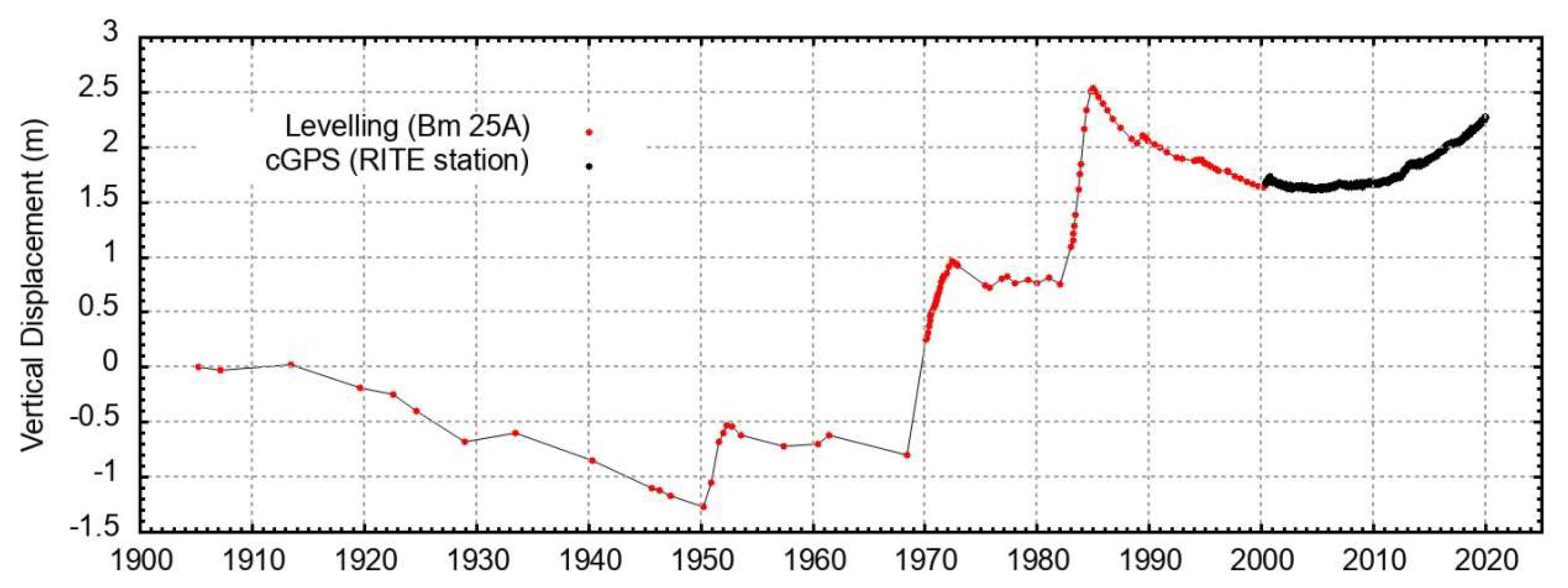
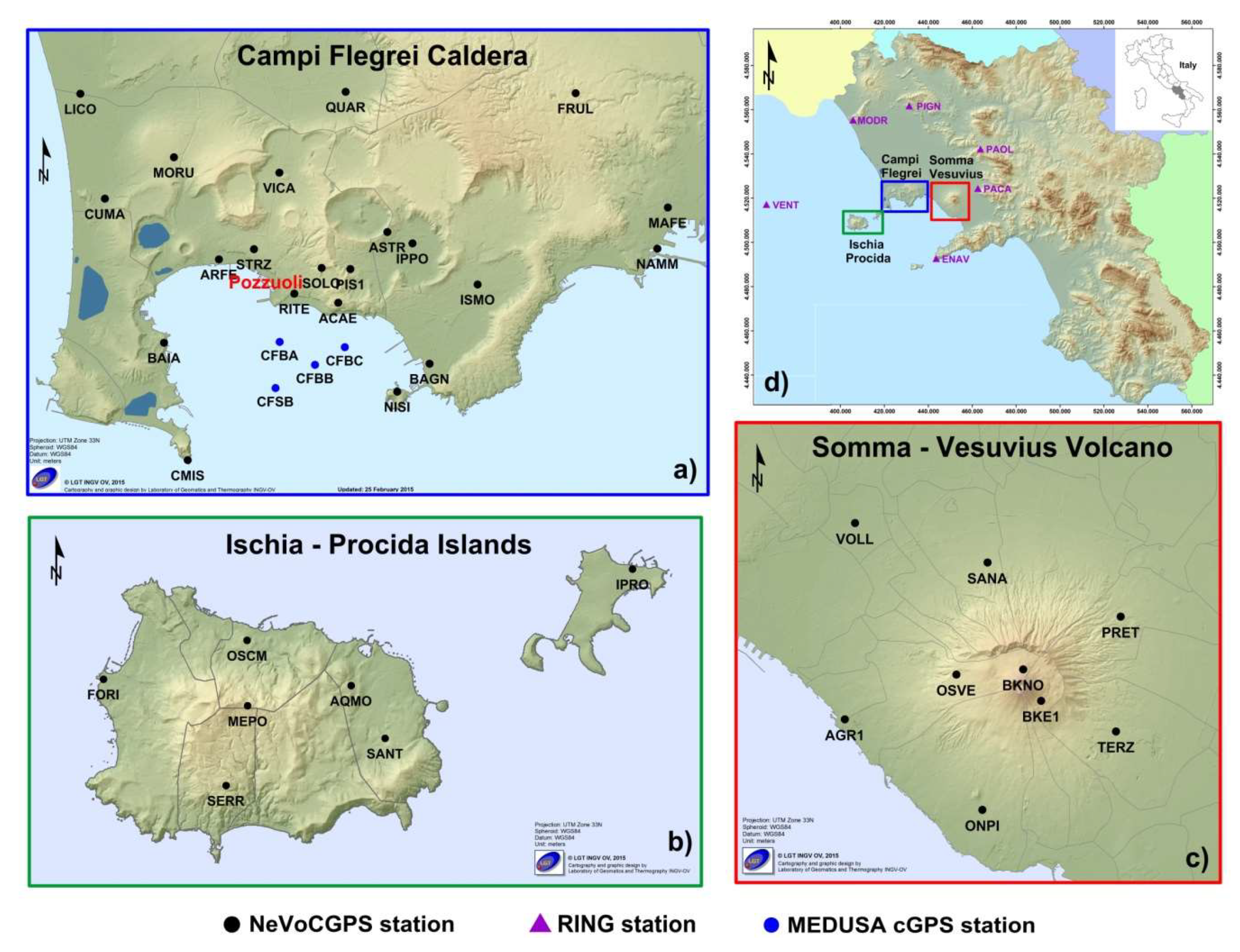
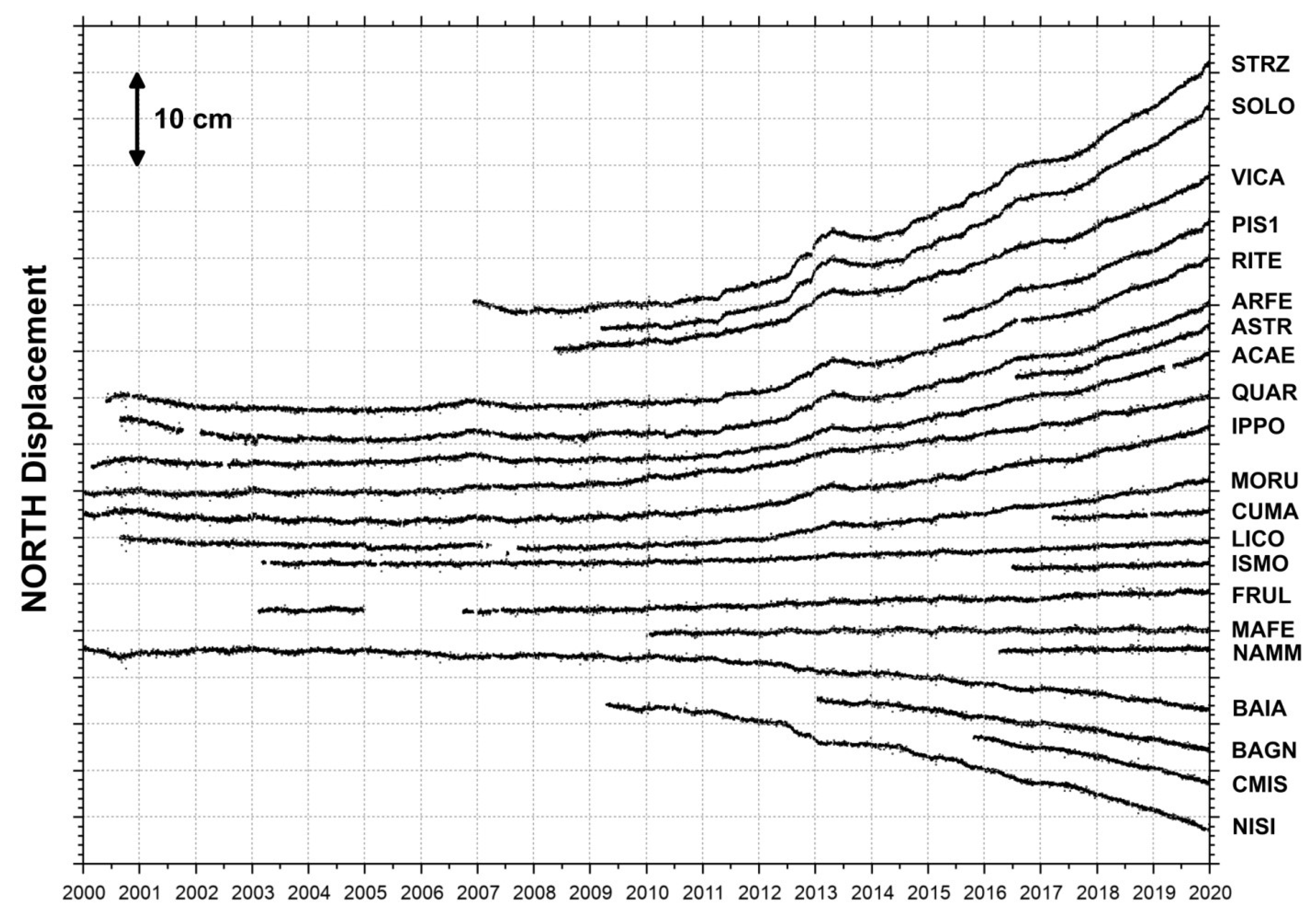
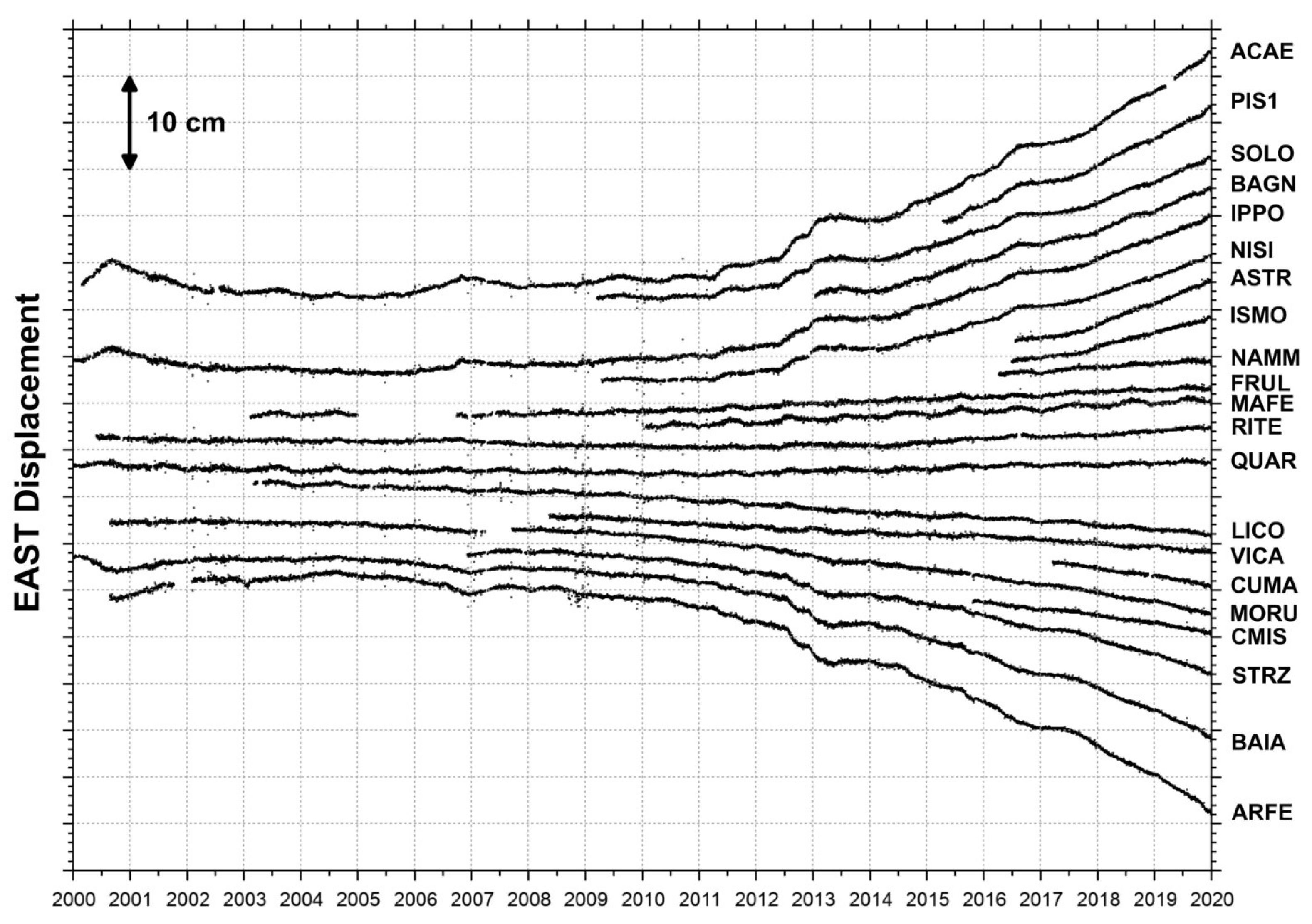
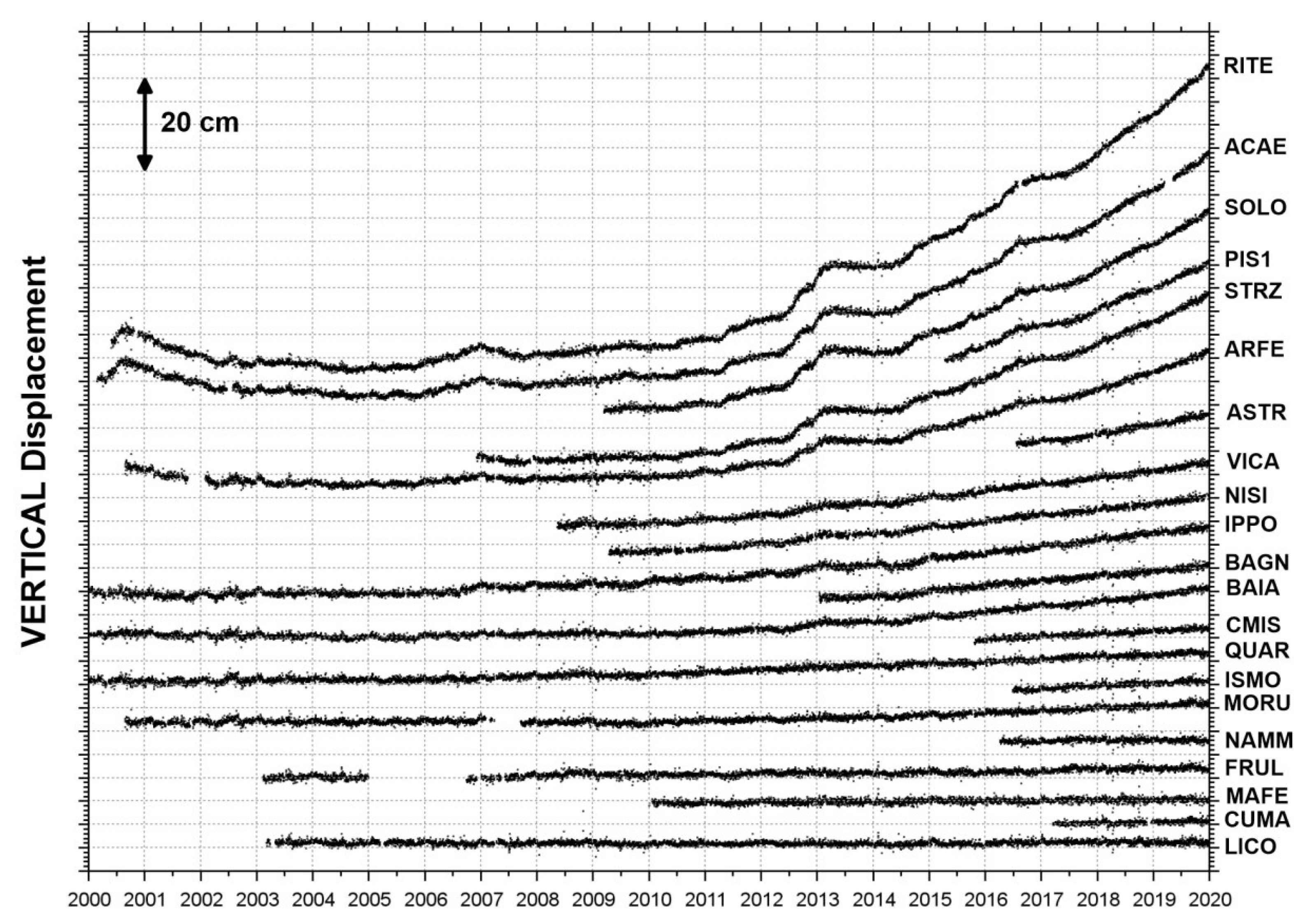
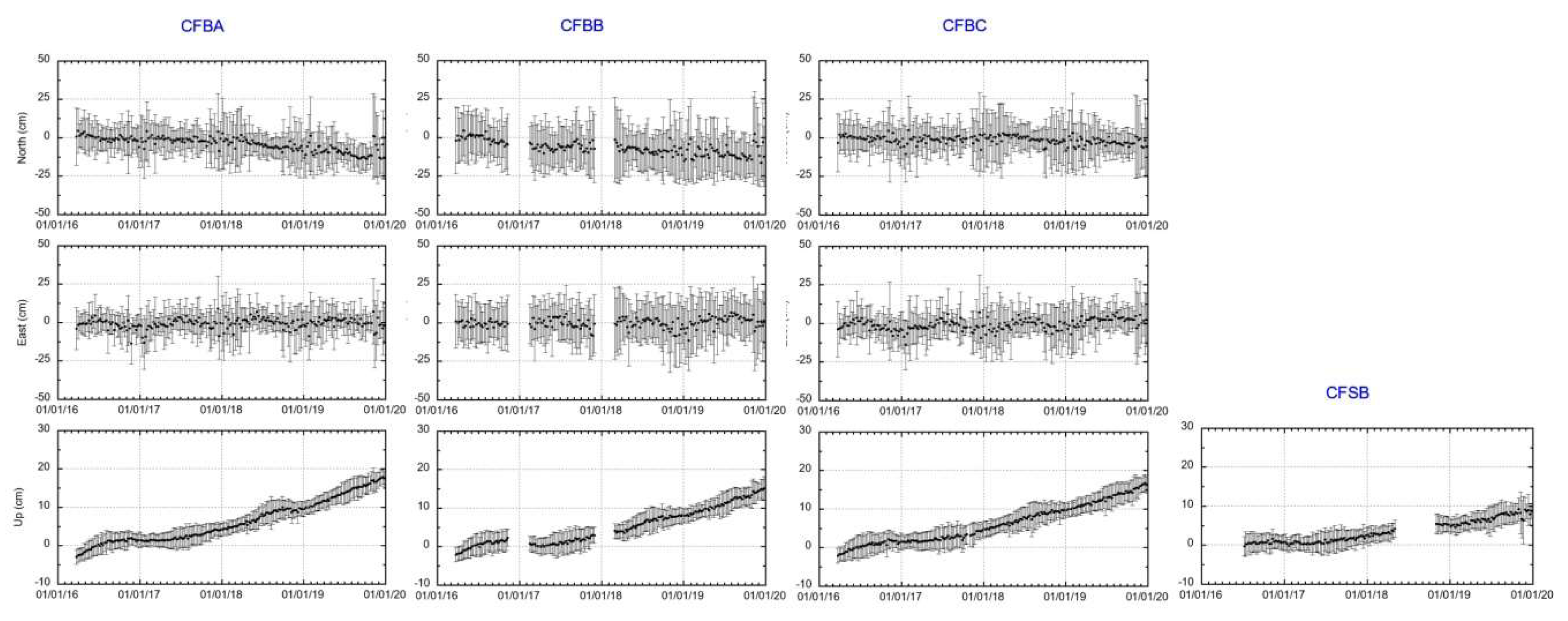



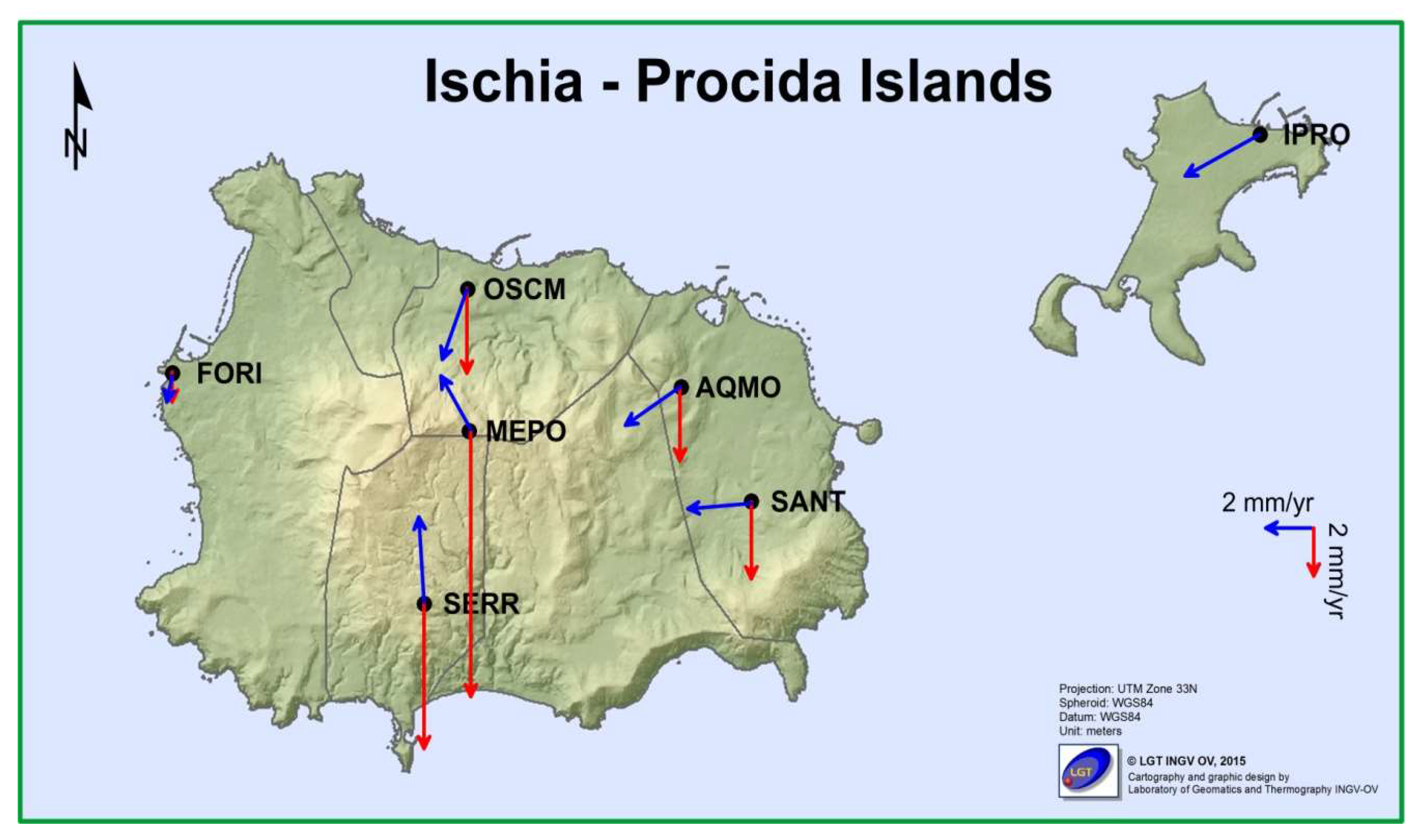

| Station | Lat N (°) | Long E (°) | First Observation (Decimal Year) | Time Span (Years) |
|---|---|---|---|---|
| Campi Flegrei Caldera | ||||
| ACAE | 40.820 | 14.141 | 2000.1 | 19.9 |
| ARFE | 40.832 | 14.099 | 2000.6 | 19.4 |
| ASTR | 40.840 | 14.159 | 2016.5 | 3.5 |
| BAGN | 40.804 | 14.174 | 2013.0 | 7.0 |
| BAIA | 40.809 | 14.080 | 2000.1 | 19.9 |
| CMIS | 40.778 | 14.089 | 2015.8 | 4.2 |
| CUMA | 40.848 | 14.058 | 2017.2 | 2.8 |
| FRUL | 40.877 | 14.225 | 2008.1 | 11.9 |
| IPPO | 40.837 | 14.167 | 2000.0 | 20.0 |
| ISMO | 40.826 | 14.191 | 2016.5 | 3.5 |
| LICO | 40.876 | 14.049 | 2003.2 | 16.8 |
| MAFE | 40.847 | 14.258 | 2010.0 | 10.0 |
| MORU | 40.859 | 14.082 | 2000.6 | 19.4 |
| NAMM | 40.836 | 14.254 | 2016.2 | 3.8 |
| NISI | 40.797 | 14.163 | 2009.3 | 10.7 |
| PIS1 | 40.830 | 14.145 | 2015.3 | 4.7 |
| QUAR | 40.877 | 14.143 | 2000.0 | 20.0 |
| RITE | 40.823 | 14.126 | 2000.4 | 19.6 |
| SOLO | 40.830 | 14.135 | 2009.2 | 10.8 |
| STRZ | 40.835 | 14.111 | 2006.9 | 13.1 |
| VICA | 40.855 | 14.120 | 2008.3 | 11.7 |
| * CFBA | 40.810 | 14.121 | 2016.3 | 3.7 |
| * CFBB | 40.804 | 14.134 | 2016.3 | 3.7 |
| * CFBC | 40.809 | 14.144 | 2016.3 | 3.7 |
| * CFSB | 40.798 | 14.120 | 2016.5 | 3.5 |
| Ischia–Procida Islands | ||||
| AQMO | 40.736 | 13.935 | 2001.1 | 18.9 |
| FORI | 40.737 | 13.856 | 2005.4 | 14.6 |
| IPRO | 40.765 | 14.024 | 2004.2 | 15.8 |
| MEPO | 40.731 | 13.902 | 2017.1 | 2.9 |
| OSCM | 40.747 | 13.901 | 2011.0 | 9.0 |
| SANT | 40.723 | 13.946 | 2013.4 | 6.6 |
| SERR | 40.712 | 13.895 | 2001.1 | 18.9 |
| Somma–Vesuvius Volcano | ||||
| AGR1 | 40.811 | 14.343 | 2003.4 | 16.6 |
| BKE1 | 40.819 | 14.439 | 2006.6 | 13.4 |
| BKNO | 40.830 | 14.430 | 2010.5 | 9.5 |
| ONPI | 40.779 | 14.411 | 2001.0 | 19.0 |
| OSVE | 40.828 | 14.397 | 2005.5 | 14.5 |
| PRET | 40.849 | 14.477 | 2001.0 | 19.0 |
| SANA | 40.869 | 14.412 | 2001.0 | 19.0 |
| TERZ | 40.808 | 14.475 | 2003.0 | 17.0 |
| VOLL | 40.883 | 14.348 | 2017.4 | 2.6 |
| Observations | Double differences |
|---|---|
| Antenna model | IGS absolute phase center corrections |
| Cut-off | 15° |
| Ambiguities | Quasi Ionosphere Free (QIF) strategy [50] |
| Ionosphere | Iono-free L3 solution |
| Troposphere | Dry-Niell a priori model for the hydrostatic troposphere and estimating the troposphere zenith delay parameters every hour at each site using the wet-Niell mapping function [51] |
| Reference system | IGb14 |
| Ocean tidal loading | FES2004 model [52] |
| STAZ | Lat N (°) | Lon E (°) | North vel (mm/yr) | North err (mm/yr) | East vel (mm/yr) | East err (mm/yr) | Up vel (mm/yr) | Up err (mm/yr) |
|---|---|---|---|---|---|---|---|---|
| ENAV | 40.582 | 14.335 | 16.6 | 0.1 | 21.8 | 0.1 | −0.5 | 0.2 |
| MODR | 41.146 | 13.881 | 17.1 | 0.1 | 21.0 | 0.1 | 0.3 | 0.2 |
| PACA | 40.870 | 14.556 | 16.9 | 0.1 | 21.3 | 0.1 | −1.3 | 0.1 |
| PAOL | 41.032 | 14.567 | 17.4 | 0.1 | 21.9 | 0.1 | 0.1 | 0.2 |
| PIGN | 41.200 | 14.180 | 18.0 | 0.1 | 21.8 | 0.1 | 0.3 | 0.2 |
| VENT | 40.795 | 13.422 | 16.8 | 0.1 | 21.4 | 0.1 | −0.9 | 0.1 |
| Mean 17.1 | Mean 21.5 |
| STAZ | North vel (mm/yr) | North err (mm/yr) | East vel (mm/yr) | East err (mm/yr) | Up vel (mm/yr) | Up err (mm/yr) |
|---|---|---|---|---|---|---|
| AQMO | −1.6 | 0.1 | −2.4 | 0.1 | −3.1 | 0.2 |
| FORI | −1.1 | 0.1 | −0.2 | 0.1 | −1.3 | 0.2 |
| IPRO | −1.7 | 0.1 | −3.3 | 0.1 | 0.0 | 0.1 |
| MEPO | 2.3 | 0.2 | −1.3 | 0.2 | −11.2 | 1.0 |
| OSCM | −2.9 | 0.1 | −1.1 | 0.1 | −3.6 | 0.1 |
| SANT | −0.2 | 0.1 | −2.8 | 0.1 | −3.2 | 0.2 |
| SERR | 3.6 | 0.1 | −0.2 | 0.1 | −6.1 | 0.1 |
| STAZ | North vel (mm/yr) | North err (mm/yr) | East vel (mm/yr) | East err (mm/yr) | Up vel (mm/yr) | Up err (mm/yr) |
|---|---|---|---|---|---|---|
| AGR1 | 0.4 | 0.1 | 0.7 | 0.1 | −0.8 | 0.1 |
| BKE1 | 0.0 | 0.1 | −1.6 | 0.1 | −6.2 | 0.3 |
| BKNO | −3.3 | 0.1 | −1.0 | 0.1 | −7.2 | 0.2 |
| ONPI | 0.3 | 0.1 | 0.1 | 0.1 | −1.7 | 0.1 |
| OSVE | −0.7 | 0.1 | 1.0 | 0.1 | −1.7 | 0.1 |
| PRET | 0.2 | 0.1 | −0.4 | 0.1 | −1.2 | 0.1 |
| SANA | −0.1 | 0.1 | 0.1 | 0.1 | −1.0 | 0.1 |
| TERZ | 0.1 | 0.2 | 0.1 | 0.2 | −2.3 | 0.5 |
| VOLL | 0.0 | 0.1 | 0.3 | 0.1 | −1.8 | 0.3 |
Publisher’s Note: MDPI stays neutral with regard to jurisdictional claims in published maps and institutional affiliations. |
© 2021 by the authors. Licensee MDPI, Basel, Switzerland. This article is an open access article distributed under the terms and conditions of the Creative Commons Attribution (CC BY) license (https://creativecommons.org/licenses/by/4.0/).
Share and Cite
De Martino, P.; Dolce, M.; Brandi, G.; Scarpato, G.; Tammaro, U. The Ground Deformation History of the Neapolitan Volcanic Area (Campi Flegrei Caldera, Somma–Vesuvius Volcano, and Ischia Island) from 20 Years of Continuous GPS Observations (2000–2019). Remote Sens. 2021, 13, 2725. https://doi.org/10.3390/rs13142725
De Martino P, Dolce M, Brandi G, Scarpato G, Tammaro U. The Ground Deformation History of the Neapolitan Volcanic Area (Campi Flegrei Caldera, Somma–Vesuvius Volcano, and Ischia Island) from 20 Years of Continuous GPS Observations (2000–2019). Remote Sensing. 2021; 13(14):2725. https://doi.org/10.3390/rs13142725
Chicago/Turabian StyleDe Martino, Prospero, Mario Dolce, Giuseppe Brandi, Giovanni Scarpato, and Umberto Tammaro. 2021. "The Ground Deformation History of the Neapolitan Volcanic Area (Campi Flegrei Caldera, Somma–Vesuvius Volcano, and Ischia Island) from 20 Years of Continuous GPS Observations (2000–2019)" Remote Sensing 13, no. 14: 2725. https://doi.org/10.3390/rs13142725
APA StyleDe Martino, P., Dolce, M., Brandi, G., Scarpato, G., & Tammaro, U. (2021). The Ground Deformation History of the Neapolitan Volcanic Area (Campi Flegrei Caldera, Somma–Vesuvius Volcano, and Ischia Island) from 20 Years of Continuous GPS Observations (2000–2019). Remote Sensing, 13(14), 2725. https://doi.org/10.3390/rs13142725






